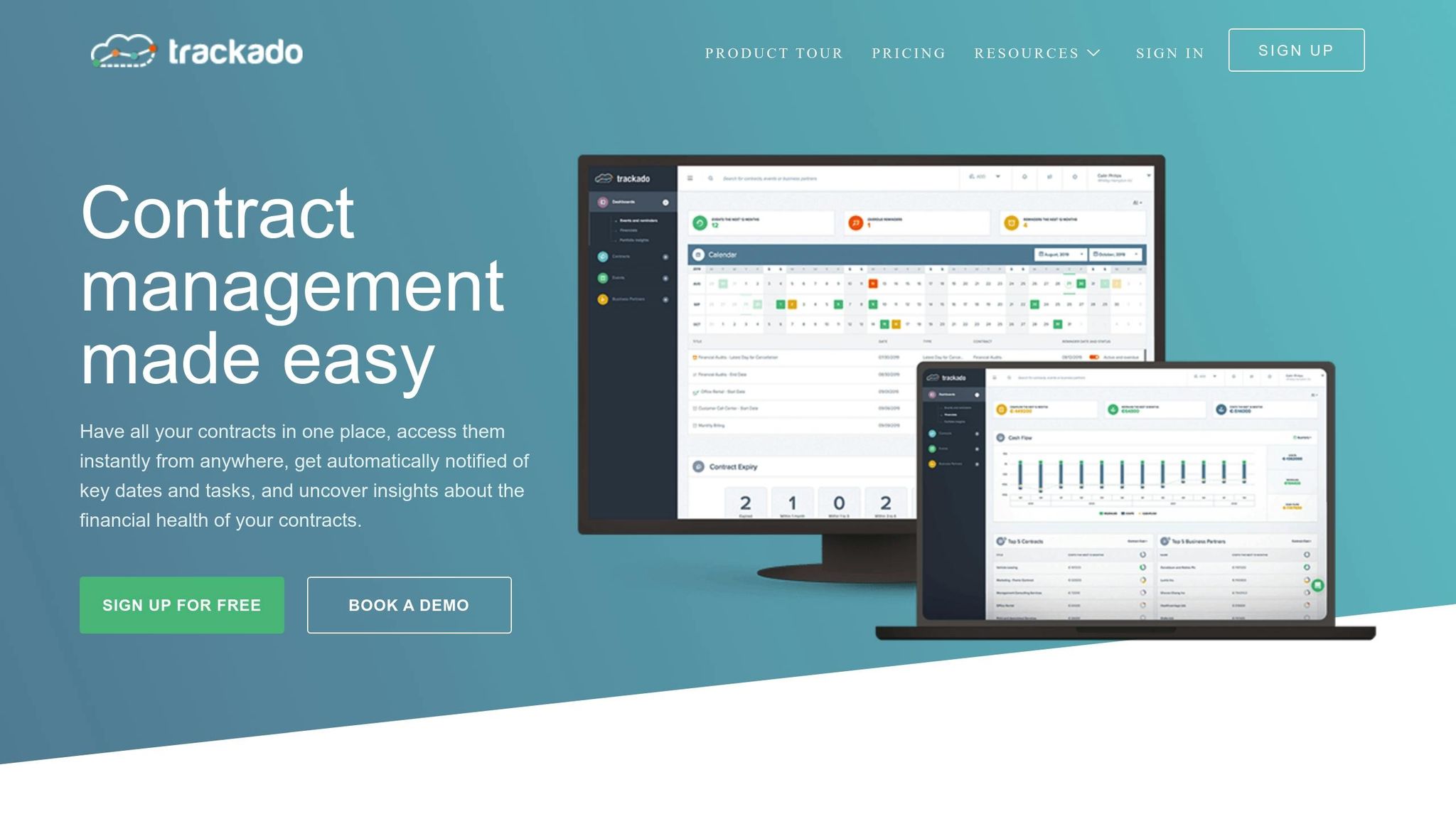
Every contract carries risks that could harm your business. From financial losses and legal disputes to reputational damage, identifying these risks early can save time, money, and partnerships. Here’s what you need to know:
- What is Contract Risk? It’s the potential for negative outcomes like missed deadlines, compliance violations, or financial penalties due to poorly written or managed contracts.
- Why It Matters: Early detection helps avoid disputes, ensures smoother operations, and keeps your business compliant with regulations like the CCPA or HIPAA.
- How to Identify Risks: Combine manual reviews, stakeholder input, and AI tools to catch ambiguous terms, risky clauses, or compliance gaps.
- Technology’s Role: Platforms like Trackado streamline risk detection by flagging issues, managing deadlines, and centralizing contracts.
- Key Risks to Watch For: Performance failures, financial/legal liabilities, operational disruptions, and reputational threats.
Takeaway: Spotting risks early isn’t just about avoiding problems – it’s about protecting your business and staying ahead. Use a mix of manual methods and AI tools to ensure no detail is overlooked.
Main Types of Contract Risks
Contracts can be a double-edged sword – they’re essential to business but can carry significant risks if not managed carefully. Below are some common areas where vulnerabilities tend to emerge, each with the potential to drive up costs.
Performance Risks
Performance risks occur when contractual obligations aren’t met. Think missed deadlines, poor-quality deliverables, or outright failures to deliver. These issues can disrupt schedules and lead to penalties. A contractor’s track record with project delays, their current workload, and financial health are often good indicators of potential performance risks.
Financial and Legal Risks
Financial and legal risks can drain resources and lead to serious liabilities. Poorly worded contracts, compliance issues, and payment disputes can all wreak havoc on cash flow and spark conflicts. Ambiguous contract terms, especially around scope, often result in unexpected costs. Regulatory violations can also be costly – like the $1.8 million fine imposed on a healthcare provider in 2023 for HIPAA violations tied to weak privacy clauses in vendor contracts. Additionally, clauses that conflict with state or federal laws can render parts of a contract unenforceable, exposing businesses to preventable losses. A thorough legal review is key to avoiding these pitfalls.
Operational and Reputation Risks
Operational and reputation risks can disrupt business and damage public perception. For instance, supplier failures can halt production, leading to substantial financial losses. A well-known example occurred in 2022, when a major U.S. retailer suffered a $5.2 million loss due to supplier delivery failures. The root cause? A contract that lacked clear penalty clauses for late shipments. Internally, issues like unclear approval processes, missing documentation, or poor communication between departments can delay projects and inflate costs. On the reputation side, publicized contract disputes can erode customer trust and complicate future partnerships.
By adopting structured contract risk management processes, organizations can lower the chances of project derailments by up to 30%.
Next, we’ll look at how to systematically identify these risks.
Methods for Identifying Contract Risks
Spotting risks in contracts requires a combination of sharp human insight and the right technology. The most successful organizations rely on a mix of strategies to catch issues before they escalate into costly problems.
Manual Risk Identification Methods
A detailed, clause-by-clause review is a classic method for identifying risks. This involves carefully examining sections on liability, warranties, compensation, termination, and dispute resolution. Missing clauses or unclear terms can pose serious risks if left unaddressed.
Contract lifecycle mapping is another useful tool. By outlining the entire process – from drafting to execution – it becomes easier to spot inefficiencies like unclear workflows, overlapping responsibilities, or approval delays. For example, one organization discovered bottlenecks and misfiled documents during their mapping process, saving valuable time and reducing errors.
Stakeholder consultations also play a key role. Bringing in legal, financial, and operations teams ensures a well-rounded risk assessment. Each department contributes insights into potential vulnerabilities, making it less likely that risks will slip through the cracks. In fact, structured consultations have been shown to reduce overlooked risks by 30%. However, manual reviews can be time-intensive and heavily reliant on the expertise and focus of those involved.
Using Technology for Risk Detection
Technology builds on manual methods by offering faster, more thorough risk detection.
AI-powered contract analysis has transformed the way risks are identified. These tools can analyze contracts in seconds, flagging risky clauses, non-standard terms, and compliance issues.
Take the example of a mid-sized US manufacturing firm that adopted an AI-driven solution in 2022. Over six months, the company cut manual review time by 40% and uncovered risks in 12% of its contracts – issues like missing indemnity clauses and outdated compliance terms. This shift led to a 22% reduction in financial losses tied to contracts.
Automated tools also provide continuous oversight by flagging sensitive data, monitoring compliance gaps, and securely storing critical information in centralized repositories.
Using Standard Templates and Checklists
While technology speeds up risk detection, standardized tools help ensure consistency and accuracy in contract drafting.
Pre-approved clause libraries are a great way to minimize risks. By relying on language that’s already been vetted for compliance and risk management, organizations can avoid unnecessary exposure caused by non-standard terms.
Risk assessment checklists offer a structured way to evaluate contracts. These checklists typically cover areas like contract types, clause reviews, party evaluations, and strategies for mitigating risks. They ensure no critical category is missed during the review process.
Template libraries streamline the drafting process while maintaining rigorous risk controls. These templates allow for automatic integration of key data – like names, dates, and values – reducing errors and speeding up transactions. With these tools, businesses can finalize contracts faster while staying within their risk management guidelines.
Step-by-Step Risk Identification Process
Taking a structured approach to identifying contract risks ensures no critical details are missed. Breaking the process into clear steps allows organizations to spot potential issues early and handle them before they turn into costly problems.
Step 1: Identify and Document Risks
Start by thoroughly examining each contract to uncover vulnerabilities and potential red flags. Begin with the basics: identify the contract type, the parties involved, and their obligations. This groundwork sets the stage for a deeper dive into the details.
Pay close attention to high-risk clauses, such as those related to liability, warranties, compensation, termination, and dispute resolution. Look for ambiguous language or missing protections. Common red flags include vague deadlines, unclear performance standards, unlimited liability, or the absence of indemnification and termination clauses. When you spot an issue, document it immediately, noting the specific clause number and page for easy reference.
Technology can make this process faster and more efficient. AI-powered tools can scan contracts in seconds, flagging risky clauses and non-standard terms that might take hours to detect manually. For instance, in 2022, a Fortune 500 healthcare company used AI-driven contract analysis to review over 10,000 supplier contracts. This initiative uncovered 1,200 high-risk agreements, addressing issues like missing indemnity clauses and personal identifiable information (PII). The result? They reduced potential liability exposure by $8.5 million in just one year.
To stay organized, create a detailed record of every identified risk. Use tools like risk registers, contract management software, or even spreadsheets to log the location, nature, and immediate concerns for each issue. This documentation becomes the foundation for the next step: evaluating the risks.
Step 2: Evaluate Risk Probability and Impact
Once risks are identified, it’s time to evaluate how likely they are to occur and the potential consequences if they do. This step helps prioritize which risks need urgent attention and which can be monitored over time.
To assess probability, consider factors such as the reliability of the contracting party, market conditions, and historical data. For example, working with a new vendor may introduce higher performance risks than partnering with a long-standing, trusted supplier.
When evaluating impact, think about both financial and operational repercussions. A missed delivery deadline, for instance, could result in penalties or disrupt critical operations. Be sure to factor in not just direct costs, but also indirect effects like reputational damage.
Visual tools like risk matrices and heat maps can help combine probability and impact assessments. Using numerical scales, these tools categorize risks into high, medium, or low priority, ensuring that the most critical threats are addressed first. Involving cross-functional teams – such as legal, finance, and operations – can improve accuracy by bringing diverse perspectives to the table. Once risks are clearly evaluated, you can move on to prioritizing and tackling the most pressing issues.
Step 3: Prioritize and Mitigate Risks
With risks documented and evaluated, the next step is to prioritize and address them. High-probability, high-impact risks should take top priority, followed by others based on their assessed urgency.
Other factors, like regulatory requirements, contract deadlines, or financial exposure, may also influence the order of priorities. For example, a compliance violation might demand immediate action, even if the likelihood of it occurring is low.
Mitigation strategies depend on the type and severity of the risk. Common approaches include renegotiating terms, adding protective clauses (like indemnities or insurance requirements), and establishing contingency plans. For instance, you might negotiate clearer performance standards, balanced liability terms, or stronger termination rights based on your findings.
Technology can play a key role here as well. Platforms like Trackado help automate risk management by centralizing contract storage, sending reminders for key dates, and issuing real-time alerts when risky clauses or sensitive data are detected. These tools ensure that risk management is an ongoing process throughout the contract lifecycle.
Regular monitoring is essential to keep up with evolving risks. Schedule periodic reviews and keep risk registers updated to stay ahead of potential threats.
| Risk Priority | Characteristics | Action Required |
|---|---|---|
| High | High probability and high impact | Immediate action, such as mitigation or renegotiation |
| Medium | Either high probability or high impact | Address promptly with defined controls |
| Low | Low probability and low impact | Monitor periodically and document for reference |
sbb-itb-49df6ae
Best Practices and Tools for Risk Identification
Managing contract risks effectively requires a mix of proven strategies, the right tools, and thorough documentation. Organizations that excel in this area combine time-tested methods with modern technology to create systems that identify and address risks efficiently.
Best Practices for Risk Management
Regular audits are essential for identifying risks in contracts. Scheduling periodic reviews helps uncover ambiguous terms, outdated clauses, or compliance gaps. These audits ensure that no emerging or overlooked risks go unnoticed.
Standardized templates play a critical role in maintaining consistency across contracts. By using pre-approved language and clause libraries, legal teams can minimize the chances of missing key protections. Regular updates to these templates are necessary to keep up with regulatory changes, industry practices, and business objectives.
Cross-functional collaboration enhances accuracy in risk detection. Legal teams contribute regulatory insights, finance teams assess financial implications, and operations teams provide practical perspectives. Together, these departments can identify risks that might otherwise be missed in a siloed review process.
Mapping the contract lifecycle is another key practice. By tracking contracts from drafting to execution, performance monitoring, and eventual renewal or termination, teams can pinpoint where risks are most likely to arise and focus their efforts accordingly.
Clear escalation procedures for different risk levels are also crucial. High-priority risks should go directly to senior leadership, while medium-priority issues can follow standard review processes. Having these pathways in place ensures timely responses and avoids delays when critical risks emerge.
Modern platforms like Trackado can further enhance these practices, making risk management more efficient and reliable.
How Trackado Improves Risk Management
Technology adds another layer of precision and efficiency to risk management. Trackado, for example, simplifies and automates contract risk identification. By centralizing contracts, it eliminates the common problem of scattered documents stored across multiple systems or email threads.
The platform’s AI-powered data extraction quickly analyzes contracts, flagging risky clauses or missing terms. Over time, the AI learns from patterns across a company’s contracts, improving its ability to detect risks that might otherwise take hours to identify manually.
Automated alerts and milestone tracking help ensure that important dates and obligations – like renewals, performance deadlines, or compliance requirements – are never missed. These notifications can be tailored to align with a company’s specific risk thresholds and priorities.
Trackado also offers customizable fields and task-based approval workflows, allowing organizations to adapt risk monitoring to their unique needs. Legal teams can set up specific fields for tracking liability caps, insurance clauses, or compliance markers, ensuring that high-risk contracts receive the necessary scrutiny before finalization.
The platform has delivered tangible results for users. For instance, Kieran Lynch, Head of Legal and Compliance at Rakuten Europe, reported smoother audits and faster access to contract data after adopting Trackado. Similarly, Peter Skeen, Head of Legal at Good Energy, shared that Trackado transformed their contract management process, making it easier to analyze contract types and improve operational efficiency. Before using the platform, managing contracts through spreadsheets was cumbersome and error-prone.
Trackado also addresses data security concerns by using European data centers with SSL encryption and enterprise-grade security features, ensuring sensitive contract information is well-protected.
Why Documentation and Reporting Matter
Thorough documentation is vital for tracking risks and ensuring accountability. Documenting risks and mitigation actions provides a clear record of who identified a risk, what steps were taken, and when the issue was resolved. This paper trail is invaluable during audits, disputes, or regulatory reviews.
Accurate records also support ongoing improvements in risk management. By reviewing historical data, organizations can identify recurring issues, refine their risk detection methods, and update templates to address common challenges.
Regular reporting keeps stakeholders informed about risk trends and the effectiveness of mitigation strategies. Reports – whether monthly or quarterly – should include metrics like the number of contracts reviewed, average time to address risks, and the most common risk types. These insights help leadership allocate resources effectively and refine processes.
Key performance indicators such as contract review completion rates, template usage, and the frequency of disputes or compliance violations should also be tracked. A 2023 study by Hyperstart revealed that companies using contract lifecycle management tools saw a 30% reduction in contract-related risks compared to those relying on manual processes.
Platforms like Trackado simplify documentation with automated features that log changes, track approvals, and maintain detailed audit trails. This not only reduces manual effort but also ensures due diligence and minimizes the risk of costly disputes throughout the contract lifecycle.
Conclusion
Identifying contract risks is a critical step in protecting both revenue and reputation. As we’ve discussed, catching risks early lays the groundwork for effective contract management. It helps avoid expensive disputes, compliance issues, and missed opportunities before they spiral out of control. Beyond just preventing problems, early risk detection improves contract performance and ensures smoother compliance.
Consider this: 68% of organizations have faced serious contract risks, and 42% of these were due to delayed identification. This data highlights why waiting for issues to become visible is no longer an option.
AI-powered tools now make it possible to analyze contracts within seconds, flagging risky clauses that might slip past manual reviews. Moving toward centralized, automated contract management isn’t just about efficiency – it’s about safeguarding business interests while enabling growth. When contracts are scattered across emails or filing cabinets, the risks grow exponentially. A centralized repository with automated alerts ensures that key dates, compliance obligations, and renewal deadlines are never overlooked. These tools underscore the value of integrating proactive risk management into every stage of your contract processes.
Key Takeaways
Here are some practical steps for managing contract risks more effectively:
- Focus on early identification. Successful organizations treat risk detection as an ongoing process. By addressing risks during drafting and negotiation, businesses can secure better terms, allocate resources wisely, and put safeguards in place.
- Use technology to complement human expertise. While manual reviews remain important, AI-powered tools like Trackado can speed up and enhance risk detection. Features like automated milestone tracking, customizable risk fields, and real-time alerts transform how risks are managed.
- Encourage collaboration across departments. Effective risk identification happens when legal, finance, and operations teams work together. Each team offers unique insights – from regulatory compliance to financial impacts – that help uncover risks others might miss.
- Document risks and track progress. Keeping a record of identified risks fosters accountability and provides data to refine risk management strategies. Metrics like review completion rates, time to address risks, and dispute frequency can help organizations continuously improve.
- Invest in automation and workflows. Tools like standardized templates, automated workflows, and centralized repositories make risk management systematic rather than reactive. While these systems require upfront investment, they lead to reduced risk exposure and greater efficiency in the long run.
Organizations that adopt these strategies not only cut costs but also achieve stronger compliance outcomes and better negotiation leverage for future contracts.
Ultimately, contract risk identification isn’t just about avoiding problems – it’s about securing your organization’s future. By combining proven methods with modern technology, businesses can transform contract management into a powerful competitive advantage.
FAQs
How do AI tools make identifying contract risks faster and more efficient than manual methods?
AI tools have revolutionized how businesses handle contract risk by automating tedious tasks and enhancing precision. Take Trackado’s AI-powered data extraction, for example – it swiftly pinpoints potential risks, key dates, and obligations, significantly lowering the likelihood of human error.
By centralizing contract management and automating reminders, AI ensures you never overlook crucial milestones like renewals or approvals. This approach not only saves valuable time but also offers better insight into contract specifics, helping you stay ahead and reduce risk effectively.
How can businesses effectively incorporate risk management into their contract processes?
To effectively integrate risk management into contract workflows, businesses should aim to simplify and centralize their processes. A tool like Trackado can help by consolidating all contracts in one secure platform, automating essential reminders, and offering detailed financial insights.
Features such as AI-powered data extraction, customizable fields, and milestone tracking make it easier to stay on top of obligations, track important dates, and minimize the chances of missed deadlines or overlooked risks. By breaking down complex tasks and providing complete visibility into contract details, companies can improve compliance and make more informed decisions.
What are performance, financial, and reputational risks in contracts, and how can they be managed effectively?
Performance risks occur when one party doesn’t fulfill their contractual duties, which can cause delays or lead to disputes. Financial risks revolve around potential monetary setbacks, like unexpected expenses or revenue gaps. Meanwhile, reputational risks arise from actions or failures that damage a company’s public image or trustworthiness.
To tackle these risks effectively, start by making sure all responsibilities are clearly outlined in the contract. Use tools to monitor progress and deadlines, and prioritize open communication with all involved parties to resolve issues early. A contract management tool such as Trackado can make this process easier by centralizing contracts, automating reminders, and providing financial insights. This way, you can stay on top of obligations and key dates while reducing the chances of surprises.






